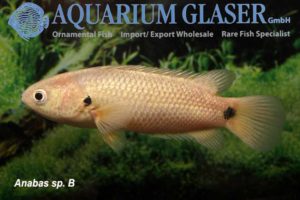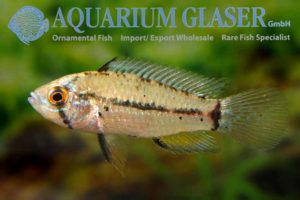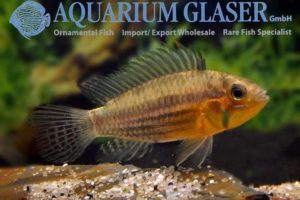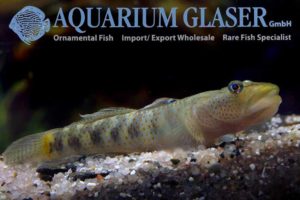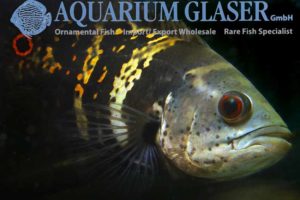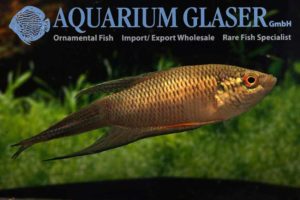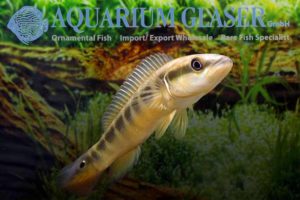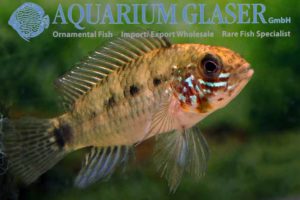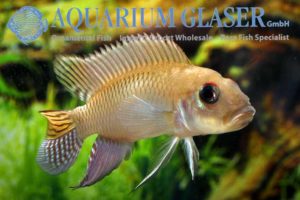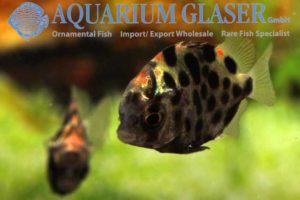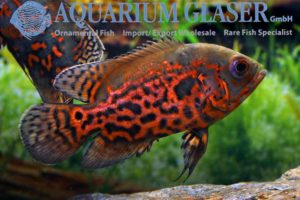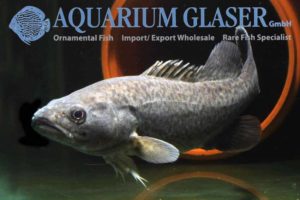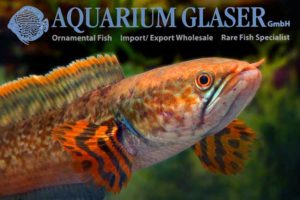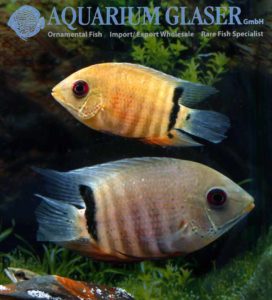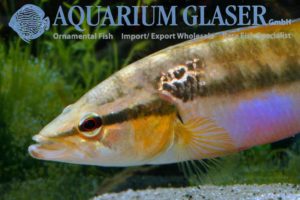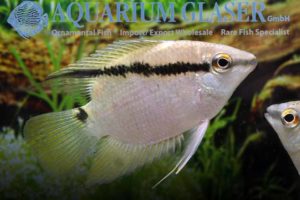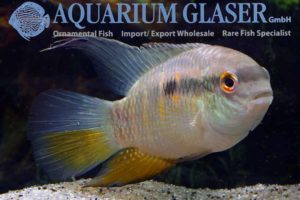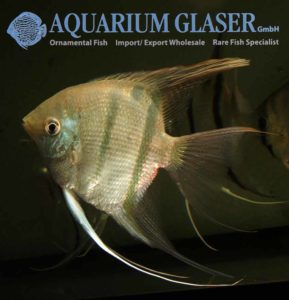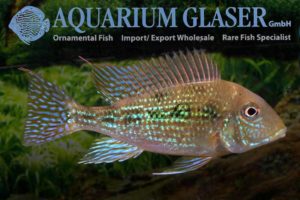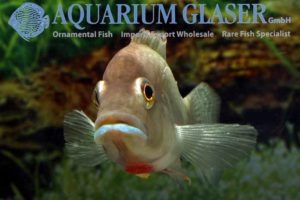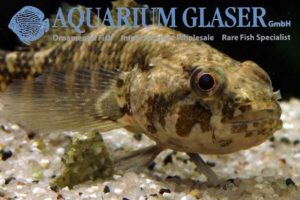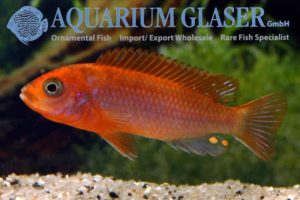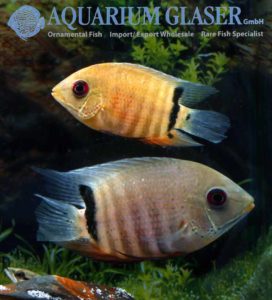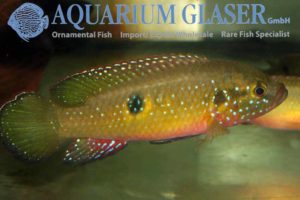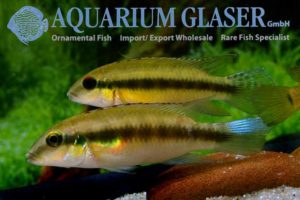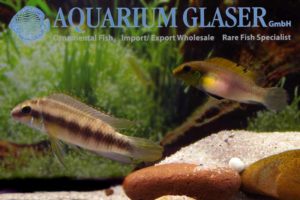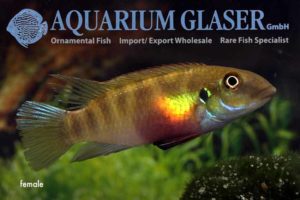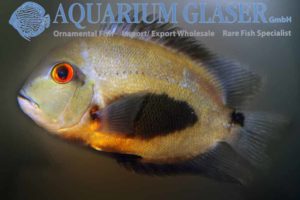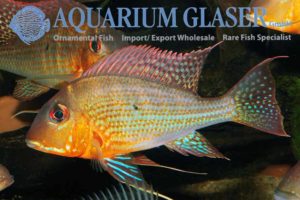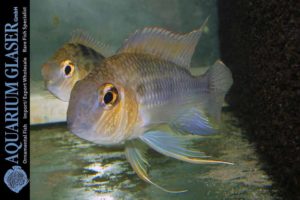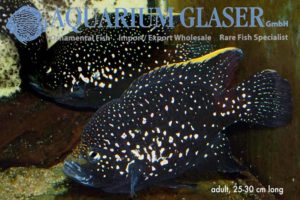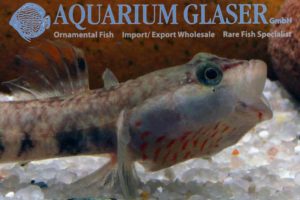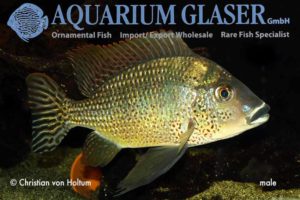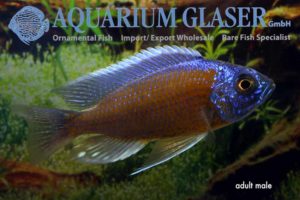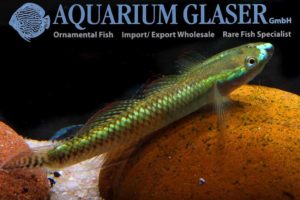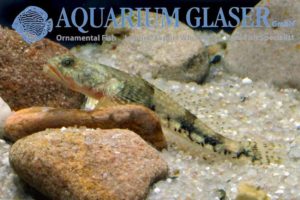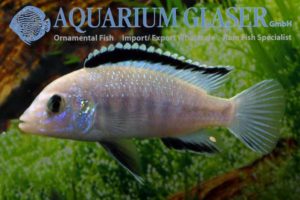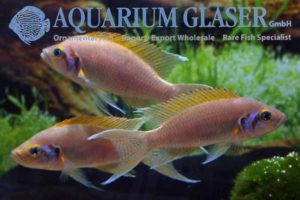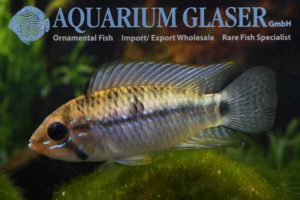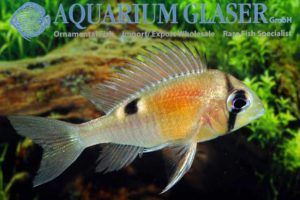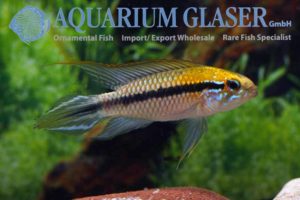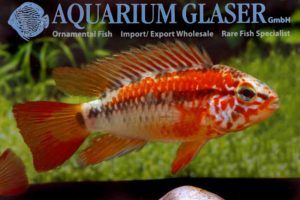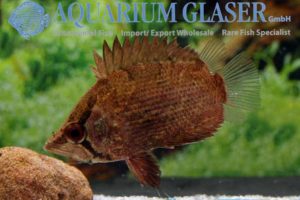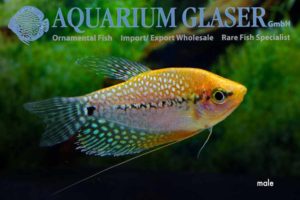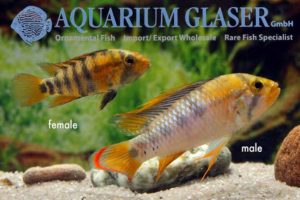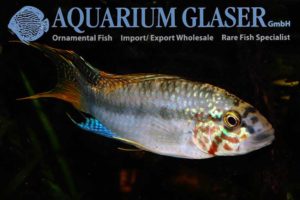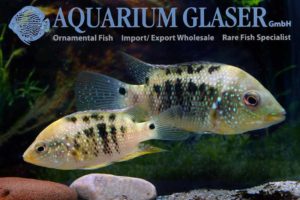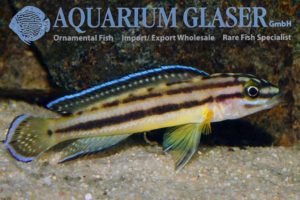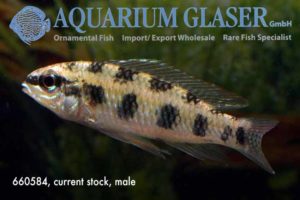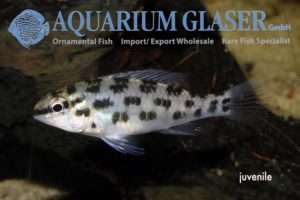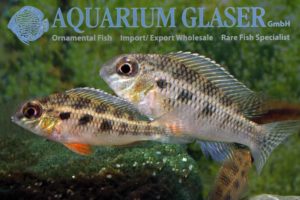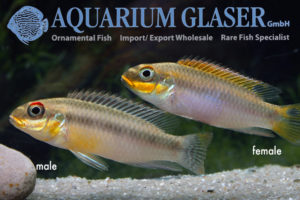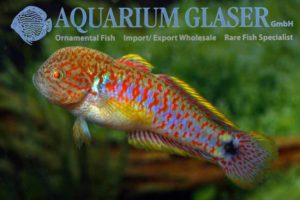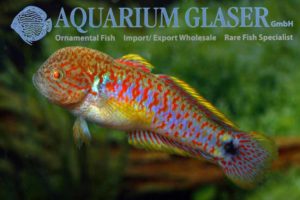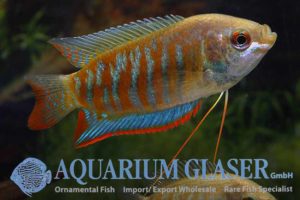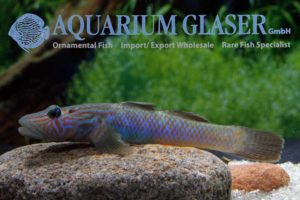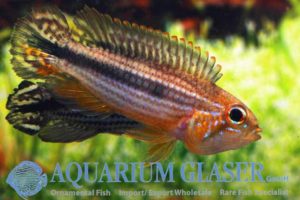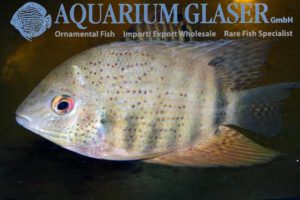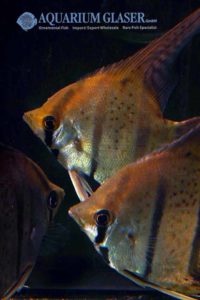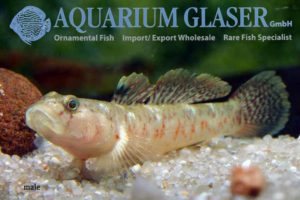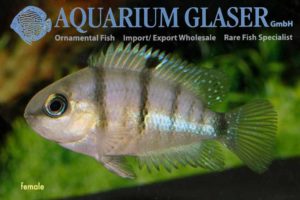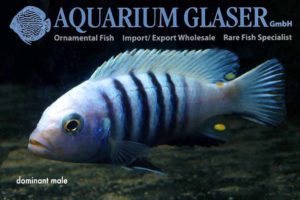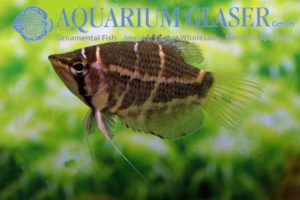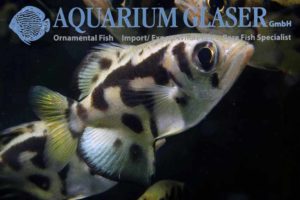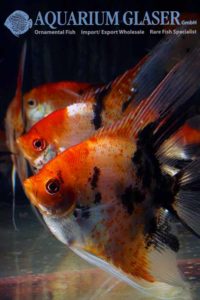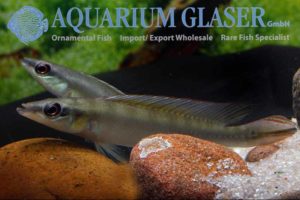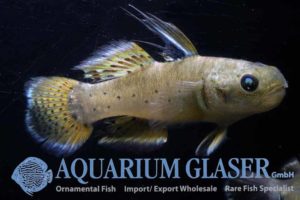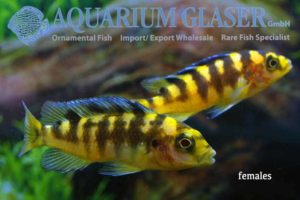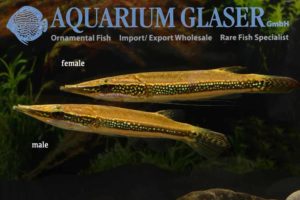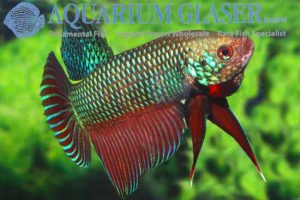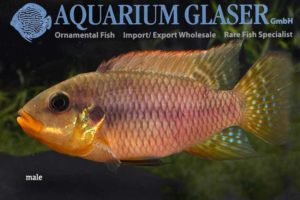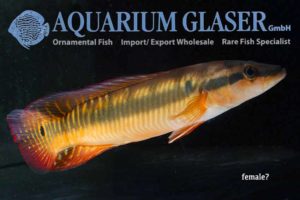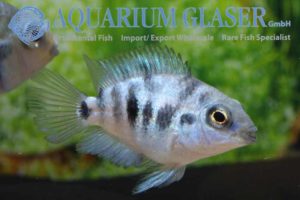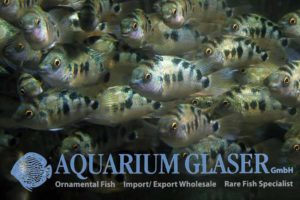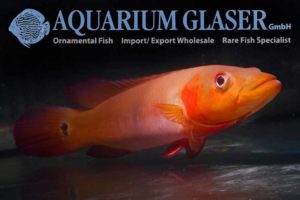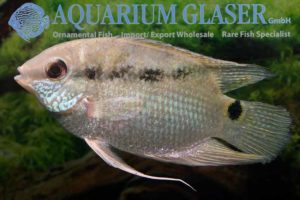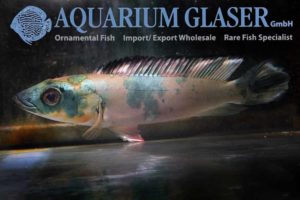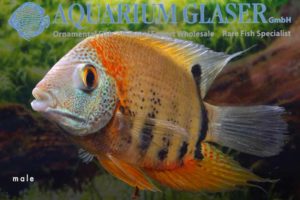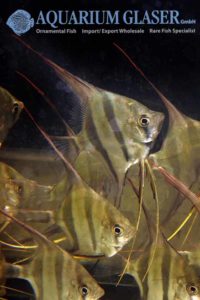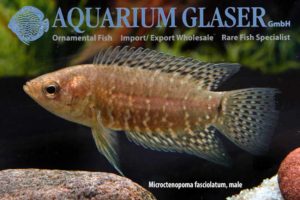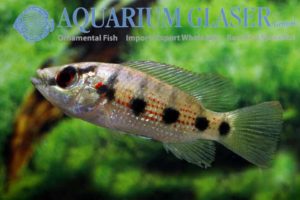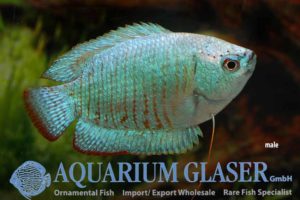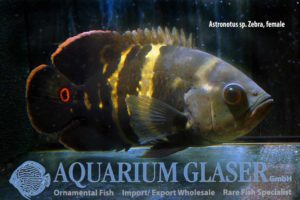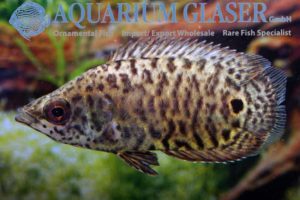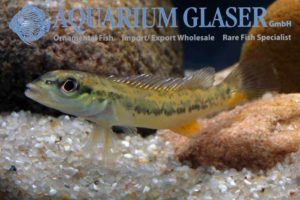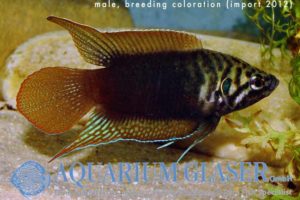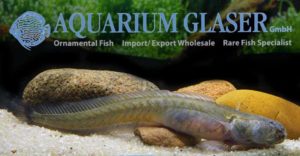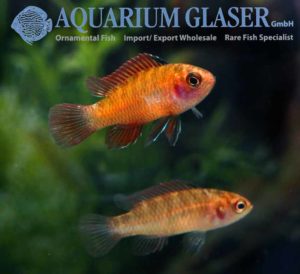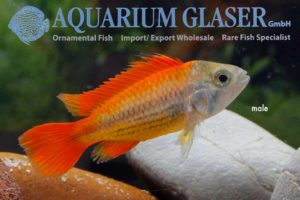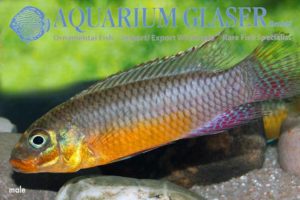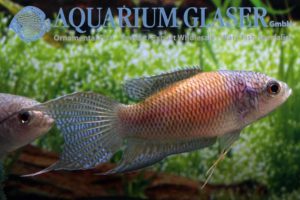Fishes of the family Anabantidae are often referred to as Climbing perches. This name bases on a species of fish that is very famous among mankind, even in people who are not much interested in fish at all: Anabas testudineus. The species is known to walk over land at wet weather to search for new […]
25. Perchlike fishes (905)
-
-
Apistogrammoides pucallpaensis
Among the dwarfs this is the smallest: Apistogrammoides pucallpaensis. This species from Peru is one of the smallest species of cichlid at all. The maximum size is given in literature with 5 cm (males) and 4 cm (females). However, this must refer to very old aquarium specimens. Wild collected ones are mature and fully grown […]
-
Apistogramma cacatuoides wild
The Cockatoo Dwarf Cichlid is one of the most popular members of the genus Apistogramma and found in petshops all over the World. Almost exclusively bred specimens of very colourful sports are traded. These do not appear in the wild. However, “the” wild form of A. cacatuoides does not exist at all. Like so many […]
-
Rhinogobius maculafasciatus
Once more we are able to offer a species of freshwater goby that was not imported so far to Europe: Rhinogobius maculafasciatus. The species has been described scientifically only in 1996 from Taiwan; our specimens originate from Taiwan. So we are comparatively sure that the determination is correct. Determination of a Rhinogobius is not that […]
-
Astronotus zebra Tapajos
Again we were able to import a small number of this splendid wild form of the Oscar. For more informations, please see http://www.aquariumglaser.de/en/fish-archive/southamerican-cichlids-en/Large_wild_collected_Zebra_Oscars_arrived__en/ For our customers: the fish have code 633426 on our stocklist. Please note that we exclusively supply the wholesale trade. Available in very limited numbers only! Text & photos: Frank Schäfer
-
Macropodus spechti
The ancient homeland of the Black Paradise Fish (Macropodus spechti, formerly M. concolor) is Vietnam. We obtained now fully grown, wonderful specimens from there. The fish are most probably bred ones, but they differ clearly from the strain bred in Europe since the 1930ies. In direct comparison the new importations show a very attractive, brass […]
-
Crenicichla semifasciata
Formerly the pike cichlids were splitted in two genera. Batrachops and Crenicichla. Batrachops were the rather blunt-headed species. Nowadays this classification is not accepted anymore and Batraochops seen only as a synonym of Crenicichla. However, hobbyists have not forgotten the old name… One of these blunt headed species is Crenicichla semifasciata from Paraguay. The attractive […]
-
Apistogramma commbrae
The species Apistogramma commbrae is only very occasionally available. The species has been described back in 1906 already and has a very wide distribution: Argentina, Brazil, and Paraguay. But from this region mainly the close relatives of A. commbrae, namely A. borellii and A. trifasciata become exported. This is not easy to understand, because A. […]
-
Nanochromis parilus
Nanochromis parilus is a species of dwarf cichlid that originates from the Congo region. Usually we offer this species as wild collected ones. But currently we found a breeder that can supply us with fully grown, very healthy, gorgeous animals. It is quite interesting that among these bred fishes two types of males appear. Some […]
-
Scatophagus
Tiny scats Scats (Scatophagus) spawn in the sea. The juveniles enter brackish water zones after their development in the plankton. From the mouths of the rivers they migrate often far inland. In India currently this migration starts and we received from there charming scat babies of 1-1.5 cm length. Juvenile scats show their realtionship: the […]
-
Astronotus ocellatus Roter Tiger Oskar
Only a Red Tiger Oscar… The man-made sport “Red Tiger Oscar” from Astronotus ocellatus is very common in the ornamental fish trade. Oscars are large cichlids that should be kept only in really large tanks. Here they are very nice pets with a great personality. However, we often do not look very intensive on such […]
-
Maccullochella peelii
Who ever looked for a really extraordinary fish as a pet will find it in this species. M. peelii is the largest freshwater fish of Australia. The popular name of Maccullochella peelii is “Murray Cod”, after the Murray River. The average length of adults is about 60 cm and 2-3 kg weight; but the largest […]
-
Channa sp. aff. bleheri “Flame Fin”
A really gorgeously coloured dwarf snakehead reached us from the foot of the Himalaya. Our specimens are obviously fully grown adults and have about 12 cm total length. Compared with all other dwarf snakeheads of that relationship in our fishhouse – Channa gachua, Ch. sp. Fire & Ice, Ch. bleheri, Ch. andrao, Ch. sp. Laos […]
-
The mouthbrooding Heros from Venezuela: a new species! Heros liberifer
At least from 1992 on Heros have been exported from Venezuela that were thought – according to scientific and hobby publications – to belong to the species Heros severus Heckel, 1840. In 1994 the aquarium community learned fascinated the fact that these “real” H. severus (all other Heros in the hobby belong to different species […]
-
Crenicichla edithae
We received this beautiful, medium-sized (around 15 cm) pike cichlid from Paraguay. Our fish represent the form that is depicted as Crenicichla cf. edithae in Stawikowski & Werner (2004: 140). Occasionally Crenicichla edithae is regarded as a synonym of C. lepidota. C. edithae has been described scientifically in 1991 by Alex Ploeg for his wife […]
-
Mesonauta acora Tocantins
We receved very interesting and very pretty flagcichlids (Mesonauta) from the Rio Tocantins in Brazil. A very special feature of these fishes is the fact that the basic pattern is extremely variable. Usually this dark basic pattern, which is shown by the fish mainly when they are stressed or excited, is species-specific. However, in this […]
-
Laetacara fulvipinnis
Only very rarely this beautiful dwarf cichlid becomes imported. Nevertheless it is known in the hobby for quite a long time. Since 1978 it was named “Aequidens sp. Orange Fin”, later, after the splitting of Aequidens and Laetacara in separate genera, Laetacara sp. “Orange Fin”. The scientifical valid description appeared only in 2007, when Staeck […]
-
Pterophyllum “dumerili”
Pterophyllum “dumerili” We received really breathtaking beautiful angels belonging to the species Pterophyllum leopoldi, among them animals in show-size. On our stocklist the fish are named P. dumerili. Although we know of course that – technically speaking – P. dumerili is only a synonym of P. scalare and our fish belong to the properly described […]
-
Geophagus mirabilis
This beautiful species of eartheater is known in the aquarium hobby since the year 2009. It is endemic in the Rio Aripuana. So it was called initially Geophagus sp. “Aripuana”. The scientific description of the species appeared much later, in january 2015. Now the correct scientific name is Geophagus mirabilis. The specific name, mirabilis, means […]
-
Ctenochromis polli (= Haplochromis polli)
One expects cichlids of the Haplochromis relationship rather in eastern Africa than in the Congo region. However, a few species appear there. Three species of the genus Ctenochromis (formerly placed in Haplochromis) live in the Congo. They are quite common in their habitat, but hardly ever exported. So they belong to the top rarities in […]
-
Butis koilomatodon
We received this sleeper goby for the first time. The animals originate from Thailand. Some author place this species also in the genus Prionobutis. It attains a maximum length of about 8 cm and is one of the smaller sleepers. Like all Butis species B. koilomatodon is able to swim and hunt in every thinkable […]
-
Labidochromis sp. Hongi “Sweden”
We received about 4 cm long bred specimens of this incredibly colourful sport. These fish do not exist in the wild. The additional name “Sweden” has been chosen, because it is said that in Sweden the food mix has been discovered that brings the unbelievable colours on the fish. For our customers: the animals have […]
-
Heros severus wild
Many aquarists know this beautiful cichlid by name, but it is only rarely found in the trade. Wild collected specimens are even rarer. We currently received wild collected specimens from Venezuela. They just start to differentiate sexually and are 7-10 cm long. Eye-spot cichlids can become as large as 20 cm. They are comparatively peaceful […]
-
Hemichromis letourneauxi
Our current import from Guinea contained also two “classical” red jewel cichlids. They were sent under the names of H. letourneauxi and H. cristatus, respecively. Initially we fully agreed with those determinations. The H. letourneauxi showed all features typical for the species, eg the comparatively elongate body and the lateral spot placed comparatively far in […]
-
Pelvicachromis humilis and close relatives from Guinea (3): Pelvicachromis humilis SIERRA LEONE & P. signatus
In this very attractive variety both sexes have a bright yellow basic colour. In males, the caudal fin is spotted, ventral fins and anal fin are red. An unique feature for this form is the eye. The upper half of the iris is bright red in males and brass in females! For our customers: the […]
-
Pelvicachromis humilis and close relatives from Guinea (2): Pelvicachromis humilis DIKINYAH and FALESADE
This variety has the following characteristics: in males, the caudal fin is yellow without any pattern, the ventral fin blue and the dorsal fin has a red border. The horizontal stripe seems to be composed of spots. The dorsal fin of the female is bright yellow and has black spots in the upper backward part […]
-
Pelvicachromis humilis and close relatives from Guinea (1): Pelvicachromis humilis LIBERIA RED
Our current import from Guinea contains five different species/morphs of the relationship of Pelvicachromis humilis. They all have in common that the males can reach a maximum length of 12 cm. Females always stay smaller. The latter are the more colorful animals, there is always a clearly marked sexual dichromatism. During mating and displaying the […]
-
Uaru amphiacanthoides SANTAREM
Once more we were able to import four wonderful specimens. They have 16-20 cm total length. One specimen, most probably a male, is obviously in mood for breeding: it reacts quite harsh against the photographer! For our customers: the fish have code 688496 on our stocklist. Please note that we exclusively supply the wholesale trade. […]
-
Geophagus cf. altifrons „Rio Araguari“
At the first glimpse one would doubtless place this fish to G. altifrons. However, there are differences. Up to a length of about 10 cm this new variety exhibits exclusively a pattern of vertical double-bars and has a comparatively large lateral spot. The dark zone between operculum and lateral spot, which is so characteristic for […]
-
Crenicara cf. punctulatum Lake Tapana
It was only quite recently that we were able to import Crenicara puntulatum from Peru. We reported on that importation here: http://www.aquariumglaser.de/en/news/Crenicara_punctulatum_Checkerboard_cichlids_part_1_en/. Now we received fully grown specimens from Brazil with an information on the collection site: Lake Tapana. These fish differ in some points from all so far described populations of Crenicara punctulatum. The […]
-
Paratilapia polleni
Many of the endemic species of cichlid from the island of Madagascar are endangered of extinction. This is due to destruction of the natural environments and the release of foreign fish species for food purposes. Sadly most of the Madagascar cichlids could not yet established as aquarium fish. An exception from that rule is the […]
-
Rhinogobius duospilus (= R. wui)
Gobies become more and more popular in the hobby. A real classic is R. duospilus, which was known under the name of R. wui for a long time. Nowadays R. wui is considered to be a synonym of R. duospilus. This small goby becomes only 4 cm long. In the wild it lives in brooks. […]
-
Tylochromis cf. lateralis German bred
For the first time ever we can offer German bred specimens of this beautiful and unusual large cichlid. The parents have been imported from the Congo. Keeping and breeding were successful under the following conditions: total hardness 14°, pH 7. The sexes show a clearly visible sexual dimorphism at an age of about 1.5 -2 […]
-
Copadichromis borleyi Kadango Red Fin
Copadichromis borleyi is a species of cichlid that inhabits Lake Malawi. It is found there pretty widespread. Males obtain a maximum length of 18 cm, females stay smaller and become only 15 cm long. The addition “Kadango” to the scientific name refers to a place in the south-east of Lake Malawi. Copadichromis are planctivorous fishes […]
-
Stiphodon atropurpureus
The neon gobies of the genus Stiphodon are all very beautiful fishes. None of the currently known 33 species becomes larger than 5-7 cm, most of them stay much smaller. Despite the fact that adult Stiphodon live exclusively in pure freshwater the larvae can develop only in marine waters. This is the reason why species […]
-
Schismatogobius roxasi
The genus Schismatogobius contents currently 10 described species. All are small, only 3-5 cm long pure freshwater inhabitants. As no species is of commercial value and the tiny fish burry themselves extremely fast in the sand when disturbed the whole genus is only very unsatisfyingly researched so far. Two species have been reported fromTaiwan: Schismatogobius […]
-
Labidochromis caeruleus WHITE
Labidochromis caeruleus is among the most popular cichlids from Lake Malawi. Usually a bright yellow sport of that fish is available in the hobby. Only comparatively recently a white sport of the fish appeared in the ornamental fish trade. It is not an artificial sport, but a variety that is found in the wild. The […]
-
Neolamprologus pulcher
Deep inside of even the straightest democrat seems to live a small royalist. How can it be explained otherways that extraordinary beautiful species of ornamental fish so often get royal popular names? The first Neolamprologus with a lunate tail fin with long filaments was imported around 1958. It very soon was called the “Princess of […]
-
Apistogramma rupununi
Finally we were able to import again this dwarf cichlid after quite a long time. Most probably our specimens originate from Amapá in Brazil. It is quite tricky to distinguish A. rupununi from A. steindachneri in small wild collected specimens. However, our recently imported fish are quite large already (some males are already about 5 […]
-
Biotodoma cupido COARI
Coari is one of the largest cities in the Brazilian state of Amazonas. From the hobbyist´s point of view, Coari is famous for its wonderful Green Discus. Now we received for the first time ever Biotodoma from Brazil which were said to have been collected nearby Coari. Even immediately after the importation the fish showed […]
-
Apistogramma gephyra Bred
Do you know the difference between Apistogramma gephyra and A. agassizii? No? Well, you are in good company with that! Both species are really difficult to tell apart. They also appear at least in some places together in the natural habitat, so the origin is of no help. Both species never hybridize in the wild. […]
-
Apistogramma viejita Variety II
Apistogramma viejita originates from Colombia. However, in the ornamental fish trade almost exclusively bred specimens can be found. There do exist several varieties even in the wild, which differ mainly in coloration (especially the content of red is very different), but also in respect of the development of the dorsal and caudal fins. Sadly the […]
-
Polycentropsis abbreviata
Polycentropsis abbreviata means roughly translated “short and similar to Polycentrus”. In fact the African Leaffish looks very similar to Polycentrus schomburgkii from South America. Both species witness the existence of the ancient super continent Gondwana. Gondwana was formed from what is now South America, Africa, India, Australia, and Antarctica. South America drifted away from Gondwana […]
-
Trichogaster leerii GOLD
The pearl gourami (Trichogaster leerii) has not been bred in different sports yet, most probably because the wild type already represents one of the most beautiful species of fish at all. But now we received for the first time a golden (lutino) sport and we have to say that this variety really has a lot […]
-
Apistogramma baenschi (= Inka I)
Apistogramma baenschi from Peru is for sure among the most beautiful species of dwarf cichlid. The male combines splendid colours (especially the wonderful caudal fin) with a fantastic high dorsal fin and the female is also a real eyecatcher due to its unique tiger pattern. Currently we have both wild collected and bred specimens in […]
-
Apistogramma sp. Diamond Face
We received some German bred specimens of that rare Apistogramma from one of our breeders currently. Initially this fish was imported in 2009 It was said to originate from the Rio Jutai in Brazil, a left hand affluent to the Amazon river (which is called Solimoes there). Since then to the best of our knowledge […]
-
Cichlasoma ornatum
Does something like mythical fish still exist? If so, Cichlasoma ornatum from Colombia and Ecuador for sure belongs to that category. Despite the fact that the species is known to science since 1905 already, only very few specimens ever swam in the tanks of enthusiasts in Europe and the US. Most probably not even a […]
-
Julidochromis marksmithi
The cichlids of the genus Julidochromis are among the most popular species of cichlid from Lake Tanganyika. Until recently five different species have been recognized. All of them are kept and bred in home aquaria. These are J. dickfeldi, J. marlieri, J. ornatus, J. regani, and J. transcriptus. The most recently described species of those […]
-
Dicrossus maculatus – Checkerboard cichlids part 3
This splendid dwarf cichlid is known to science since 1875, but almost never found in home aquaria. This is a great pity, because there are hardly any species that are as beautiful as this one and simultaneously as peaceful! Males become around 9 cm long, females about 6 cm. The animals we currently have in […]
-
Dicrossus foirni (= sp. Rio Negro): checkerboard cichlids, part 2
Finally Dicrossus foirni is available again! This extremely rarely imported dwarf cichlid was formerly known in the hobby under the name of Dicrossus sp. “Rio Negro”. These fish are a real eyecatcher when fully grown. Keeping this jewel is not complicated at all, but for breeding extreme water conditions are necessary (pH below 5, hardness […]
-
Crenicara punctulatum – Checkerboard cichlids, part 1
Currently we have several species of checkerboard cichlids (genera Crenicara and Dicrossus) in stock. Most of them are real rarities in the hobby, among them Crenicara punctulatum. We obtained this pretty species from Peru. Males of Crenicara punctulatum can attain a maximum length of about 12 cm, so this species is not a dwarf cichlid […]
-
Pelvicachromis taeniatus
Once more a change of names of well-known aquarium fishes appeared. The different forms of Pewlvicachromis taeniatus have been regarded for decades as mere colour varieties of the very same biological species. But now a new study has been published which laces almost all “varieties” from Cameroon under the taxon Pelvicachromis kribensis. Only one “variety” […]
-
Tateurndina ocellicauda
We received wonderful, fully grown bred specimens of this beautiful, small freshwater goby. Dominant old males develop a mighty humphead, females a round belly swollen from eggs. For more information, please see http://www.aquariumglaser.de/en/fish-archive/miscellaneous-en/Tateurndina_ocellicauda_en/ For our customers: the fish have code 461004 on our stocklist. Please note that we exclusively supply the wholesale trade. Text & […]
-
Tateurndina ocellicauda
This wonderful goby originates from Papua-Newguinea, but in the trade almost exclusively bred specimens are available. The fish belongs to the so-called sleeper-gobies. These fish have been named after a reflecting layer over their eyes. This looked for the first observers as if the fish would have closed its eyes for sleep. T. ocellicauda becomes […]
-
Colisa fasciata bred
We received breathtaking beautiful specimens of Colisa fasciata from Singapore. This species is an ideal tankmate for nice community tanks with small, peaceful barbs, minnows etc. and a dense plantation. For our customers: the fish have code 411104 on our stocklist. Please note that we exclusively supply the wholesale trade. Text & photos: Frank Schäfer
-
Rhinogobius formosanus
We received again this pretty freshwater goby from Taiwan. The determination of the numerous species of Rhinogobius is often very difficult (see also http://www.aquariumglaser.de/en/rhinogobius-rubromaculatus_en_1637.html). R. formosanus is a pleasant exception of that rule, for it differs from all species of Rhinogiobius from Taiwan by the unique red coloration of the face. Taiwan was formerly known […]
-
Apistogramma agassizii Tefé
We received extremely beautiful wild collect specimens of this most desirable variety of Apistogramma agassizii. The fish show the stripes on the belly, which are so characteristic for the Tefé-variety and additionally they have the yellowish-reddish back of the Santarém-variety. Gorgeous! For our customers: the fish have code 614772 on our stocklist. Please note that […]
-
Heros cf. efasciatus Japaueri
We received from Brazil beautiful wild collected Heros. According to our supplier the fish have been collected in the Rio Negro in the municipal Japaueri. The most obvious difference to other varieties of Heros are the red spots all over the body. Besides this the new imported Heros obviously become sexually ripe quite early. Our […]
-
Pterophyllum wild “leopoldi Peru spotted”
We received two species of wonderful, large, wild collected angels from Peru. One of them is traditionally called “Pterophyllum leopoldi” in the hobby. It has a reddish back and a number of red spots on the flanks. The name, however, bases on a mis-identification. The “real” P. leopoldi originates from Brazil and is in truth […]
-
Rhinogobius rubromaculatus
In the aquarium hobby we only started in discovering the large diversity of the small freshwater gobies of the genus Rhinogobius. This time the scientists were faster: 116 species have been described to date already! Sadly the distinguishing features that allow the determination of the species cannot be seen in many cases in live specimens. […]
-
Cryptoheros cutteri
We received very nice German bred specimens of this smaller cichlid from Honduras. Despite the comparatively small size – males obtain a maximum length of 13 cm, females always stay smaller – one should not keep these cichlids in small tanks. They have a very vivid temper, especially when they care for the offspring. The […]
-
Cynotilapia pulpican
At the first glimpse Cynotilapia look very much alike the Malawi Zebras of the genus Maylandia In contrast to the zebras, in Cynotilapia the teeth are monoscupid (with two cusps in zebras). This difference is of more importance than one should think, for the zebras feed on Aufwuchs (eg the algae film on rocks etc. […]
-
Sphaerichthys selatanensis
Sphaerichthys selatanensis The season for crossband chocolate gouramis has started. Finally the pretty small anabantoid is available again. For more information please see http://www.aquariumglaser.de/en/fish-archive/labyrinthfish-en/Sphaerichthys_selatanensis_en/ For our customers: the fish has code 455822 on our stocklist. Please note that we exclusively supply the wholesale trade. Text & photos: Frank Schäfer
-
Toxotes blythii
This archer fish that lives exclusively in freshwater originates from Burma. It has been discovered as early as 1860 and received its correct scientific name in 1892. Since then it has not been found anymore. Only in 2004 the first specimens appeared in the international trade and were celebrated as a sensation. These first specimens […]
-
Scalare Red Devil Show Size
We received 50 gorgeous, fully grown Red Devil Angels. The fish are German bred ones. Our opinion is: more colour is impossible! For our customers: the fish have code 697565 on our stocklist. Please note the we exclusively supply the wholesale trade. Text & photos: Frank Schäfer
-
Crenicichla regani Alenquer
The pike cichlids (Crenicichla) represent the most species-rich genus of cichlid at all. More than 130 species have been described. How many of them are valid is subject of discussions, but the number for sure increases to over 90. Some species become pretty large, more than 30 cm, but there are also real dwarf cichlids […]
-
Stigmatogobius sadanundio
Most species of goby are ground dwelling fishes. Only few species have a free swimming behaviour. The knight goby is one of these rare exceptions. We can offer this pretty goby from India on a regular basis. Knight gobies live in estuaries and can live both in pure fresh and in pure marine water. However, […]
-
Pseudotropheus crabro
The colorful mouthbrooders from Lake Malawi – the so called mbuna – belong to the most popular aquarium fish over decades already. They are also called the “coralfish of freshwater”, for – like their salty relatives – they unite splendid colours and a rather quarrelsome temper. The latter is due to the very restricted food […]
-
Luciocephalus aura
The pikeheads (Luciocephalus) are highly specialized labyrinth fish. They live as predators in blackwaters of Southeast Asia. Only two species are known, the “common” pikehead, which occurs on the Malay Peninsula and in Indonesia, and the Peppermint Pikehead, which is known so far only from the Province Jambi on Sumatra. Currently we are able to […]
-
Betta smargdina wild
-
Benitochromis riomuniensis
We have some wild collected specimens of Benitochromis riomuniensis from Cameroon in stock. Benitochromis is closely related to the Pelvicachromis species and can be compared regarding the aquarium biology quite good with these peaceful and colorful cichlids. In contrast to Pelvicachromis, which are cave brooders, Benitochromis are biparental, ovophilous mouthbrooders. This means that both parents […]
-
Crenicichla zebrina
Does there exist anything like a dreamfish even in our days? Well, at least Crenicichla zebrina from Venezuela is a hot candidate! We were able to import two specimens of this top rarity which have a length of 15-20 cm. So far no external features are known for that species to separate males from females. […]
-
Amatitlania sp. Honduras Red Point
The Convict cichlid (Amatitlania nigrofasciatum, formerly Cichlasoma, Archocentrus or Cryptoheros nigrofasciatus) was for a long time one of the most popular species of cichlid in the aquarium. Nowadays it becomes rather rarely seen. Instead of that species another Amatitlania appreared some years ago on stage, named Amatitlania sp. “Honduras Red Point”. These fish seem not […]
-
Amatitlania sp. Honduras Red Point
Recently we could introduce to you this pretty dwarf cichlid that belongs to the closer relationship of the Convict cichlid (Amatitlania nigrofasciatum, formerly Cichlasoma n.), see http://www.aquariumglaser.de/en/news/Amatitlania_sp_Honduras_Red_Point_en/Now we obtained again specimens from our proved breeder. For our customers: the animals have code 674452 on our stocklist. Please note that we exclusively supply the wholesale trade. […]
-
Crenicichla sp. Tapajós
At the beginning of this week we introduced to you the dwarf cichlid Teleocichla proselytus from the Rio Tapajós (see http://www.aquariumglaser.de/en/news.php#1040). A close relative, but much, much bigger is the gorgeous red Crenichichla sp. Tapajós that originates from the same river. The species is not described scientifically yet. Females (sadly too shy for a good […]
-
Mesonauta festivus
We received from Brazil very nice, wild collected flag cichlids. M. festivus is usually not kept due to its coloration, which is not very spectacular, but due to the interesting and peaceful behaviour. But the animals that reached us now have a very interesting, blue pattern in the face. The scales also show an attractive […]
-
Crenicichla lugubris Jutai
Once more we were able to import some specimens of this gorgeous large cichlid from the Jutai region. This time the shipment contained one male with an extraordinary marble pattern. For more informations please click http://www.aquariumglaser.de/en/news/Crenicichla_lugubris_Jutai_en/ For our customers: the fish have code 670746 on our stocklist. Please note that we exclusively supply the wholesale […]
-
Heros cf. efasciatus Red Shoulder
We received wonderful wild collected specimens of this extraordinary species from Peru. Currently the fish are 9-12 cm long. Experts are still debating whether these fish belong to the species Heros efasciatus or to a scientifically still undescribed species of Heros. But all agree that they represent the most attractive Heros at all. Males can […]
-
Altum angels: bred ones available!
We obtained very beautiful German bred Pterophyllum altum. The “Orinoco” strain is characterized by the very good shape of the body and a high degree of red in the fins. For our customers: the fish have code 698303 on our stocklist. Please note that we exclusively supply the wholesale trade. Text & photos: Frank Schäfer
-
Microctenopoma fasciolatum
Our current import from the D.R. Congo contains inter alia two pretty species of dwarf bushfish: Microctenopoma ansorgii and M. fasciolatum. While M. ansorgii, the Orange bushfish, is imported on a rather regular basis, M. fasciolatum is found only very rarely in the trade. The Striped bushfish – this is the common name of M. […]
-
Hemichromis elongatus
The Five Star General has a very wide distribution in western Africa and is one of the most beautiful species of cichlid at all. Sadly it is also one of the most aggressive species of cichlid and this is the reason why it is only very rarely seen in aquaria. The photographed specimens originate from […]
-
Colisa lalia Cobalt
Dwarf gouramis are the orchids among the freshwater aquarium fish. They are extremely beautiful, but also a bit of delicate, but if kept properly they are real eyecatchers. The Cobalt sport was developed only in the 1990ies and became very popular. Today the fish is among the most common species found in the ornamental fish […]
-
Large wild collected Zebra Oscars arrived!
The Oscar (Astronotus ocellatus) is by far the most popular species of large cichlid from South America. This is not only because it is so splendid coloured, but also due to its behaviour: the fish becomes much larger than 20 cm, but is of calm nature and can thus be kept and bred properly in […]
-
Ctenopoma acutirostre wild
The current import from the D. R. Congo also contained some wild collected leopard bushfish. This species is available as bred from Indonesia in the last years (see http://www.aquariumglaser.de/en/archiv.php?news_id=140), but wild collected ones are very rare in the trade. The animals show an extremely variable pattern, each individual has a different coloration. One of our […]
-
Teleocichla proselytus
We received this very rarely offered dwarf cichlid from the Rio Tapajós in Brazil. Like in the humphead cichlids of the genus Steatocranus in Africa, Teleocichla have a reduced swimming bladder; because of that they exclusively live near the bottom. Our specimens have very nice orange colours in the fins. For our customers: the fish […]
-
Macropodus ocellatus wild
Finally we were able to import again wild collected Chinese Paradise fish. The currently imported variety shows an interesting striped pattern in neutral mood. Males in breeding mood look wonderful and have very splendid colours. However, as our animals are not in breeding mood yet, we show here exceptionally a picture of a male that […]
-
Odontamblyopus rubicundus
This goby from the lower reaches of the river Ganges belongs clearly to the category “faces that can be loved only by a mother”. Despite the look the fish that can reach up to 25 cm in length are very interesting. One should be careful with possible tankmates. Any fish that fits the mouth will […]
-
Dario hysginon (2)
The species of Dario – the Dwarf Badis – are in one respect comparable to their larger cousins of the genus Badis: they are Chameleon fish! Depending on mood or light the colours change a lot and fast. We have once more the Flame Red Dario, D. hysginon, from Burma in stock. The species becomes […]
-
Apistogramma cacatuoides Mega Orange
An orange sport of the cockatoo dwarf cichlid is already known for quite a long time. But now we received for the first time a new strain that has really wonderful orange coloration. The breeder calls it “Mega Orange” – and we agree! For our customers: the fish have code 617343 on our stocklist. Please […]
-
Pelvicachromis taeniatus Bipindi
Currently we can offer a great number of wild collected varieties of P. taeniatus from different localities in Cameroon. The local variety from Bipindi is characterized by a high degree of yellow colours, the females get a wonderful blue belly when displaying. For our customers: the fish have code 562702 on our stocklist. Please note […]
-
Macropodus erythropterus
Not much has been heard in the past few years about this beautiful paradise fish from Vietnam. This might be connected with the dispute about the validity of the species which has been considered to be a mere synonym of M. spechti (formerly: M. concolor) by some scientists. We recently obtained bred specimens that clearly […]
The fourth Retroculus has been described
In our newsletter from the last weekend we mentioned that besides the three described species of Retroculus also an undescribed one exists. Sadly we overlooked that the undescribed has been in fact described in June this year: Retroculus acherontos from the Rio Tocantins. The species is distinguished from all other species of Retroculus by a hump on the fronthead (visible in specimens from 12-13 cm length) and the fact the the dark spot in the soft part of the dorsal fin is situated in the median part of that fin and not, like in all other Retroculus, near the back. Additional species differences are not visible in live fish.
As far as we know this beautiful fish has not been imported yet. Pictures of freshly captured, living fish can bee seen in the most current issue of Amazonas Magazine (No 61 for September/October 2015).
Literatur: Landim, M. I. , C. R. Moreira and C. A.
Figueiredo (2015): Retroculus acherontos, a new species of cichlid fish
(Teleostei) from the Rio Tocantins basin. Zootaxa 3973 (no. 2): 369-380
Text: Frank Schäfer
Gorgeous Dicrossus maculatus arrived!


Dicrossus
maculatus belongs for sure to the most beautiful dwarf cichlids at all.
But we hardly ever have seen so pretty specimens like the ones we
currently were able to import!


The
photos are taken from specimens we currently have in stock. The water
in the photo-tank has been coloured with dead leaves to a strong amber
colour in order to make the fish feel as comfortable as possible.
However, on the photos this gives a impression of more yellow-orange
coloration on the body than is extant. But we hesitated to correct this
by Photoshop, for the overall colours would look unnatural in that case.

For our customers: the animals have code 668506 on our stocklist. Please note that we exclusively supply the wholesale trade.
Text & photos: Frank Schäfer
Wild collected Oscars from Brazil


Once
more we were able to import four wonderful, large (18-25 cm) specimens
of the Oscar cichlid from Brazil. There is no consensus among scientists
how many species should be assigned to the genus Astronotus. Most
scientists accept only two species, namely A. crassipinnis and A.
ocellatus. Others believe that there are many more species and that the
genus Astronotus is urgently in need of a scientific revision. We think
that the four current imports belong to three different species. So we
do not use scientific specific names here.


A
beautiful pair reached us from the state of Pará. The male has a high
degree of red all over the lower part of the body, whereas in the female
the red colours are restricted basically to the region around the
opercle. We are sure that fish like these were among the ancestors of
the artificial sport called “Red Tiger Oscar”.


Two
other specimens reached us from the Rio Tapajós. They most likely
represent two different species or the sexual dimorphism is extreme in
this population of Oscar. One of the specimens is very slender and has a
nice yellow basic colour. The other specimens reminds us strongly to
the “Zebra” we were able to import last year (see http://www.aquariumglaser.de/en/fish-archive/southamerican-cichlids-en/Large_wild_collected_Zebra_Oscars_arrived__en/), but this time the bright vertical stripes are rather reddish and the animal has a great number of black speckles in the face.


For
our customers: the fish have code 633427 (Tapajós) and 632528 (Pará) on
our stocklist. Please note that we exclusively supply the wholesale
trade.
Text & photos: Frank Schäfer
New: Betta splendens Special A-Selection

Of course we offer already for a long time high quality Veiltail-Bettas and several selective sports. Now we offer additionally a colourful mix of several a-grade special sports. Our supplier has sampled a number of fish that can be shipped in such a mix, for example crowntails, double tails, half moons, butterflies, and, and, and…..
For our customers: the special a-selection has code 391013 on our stocklist. Please note that we exclusively supply the wholesale trade.
Text: Frank Schäfer, photos: Nitipat Bhandhumachinda
Discus season started!

Every
year we eagerly await the start of the season for wild collected
discus. Now it has started finally and we received, for example,
breathtaking beautiful Royal Blues from Oriximina (Rio Trombetas), among
them show animals with a length of about 14-17 cm (see photos). But we
also obtained smaller specimens, which are also very beautiful…

For
our customers: the fish have code 731064 (8-12 cm), 731065 (12-15 cm),
731066, and 731076 (14-17 cm) on our stocklist. Please note that we
exclusively supply the wholesale trade.
Text & photos: Frank Schäfer
Brown-red Discus Madeira Nova Olinda do Norte

Madeira
discus are famous for the high degree of red colours for decades
already. Last week we received beautiful, brown discus from the Madeira
region with the additional name “Nova Olinda do Norte”. Besides the nice basic
coloration the pretty light coloured, almost white dorsal fin is worth
mentioning in our newscomers.

For our customers: the fish have code 732014 on our stocklist. Please note that we exclusively supply the wholesale trade.

Text & photos: Frank Schäfer
Pearl cichlids – German bred ones available!

The
Pearl cichlid has been imported and successfully bred in Germany as
early as 1902. In the meantime there were several changes regarding the
name. Formerly known under the name of Cichlasoma cyanoguttatum it is
now a member of the genus Herichthys. It is believed that the large
spotted form, which we can offer right now as German bred ones, belongs
to the species Herichthys carpinte that originates from Mexico, whereas
the small spotted form is thought to represent the “real” Herichthys
cyanoguttatum. The latter is the only native cichlid of the US and the
northernmost species of cichlid at all.


Sadly
Pearl cichlids are almost forgotten nowadays. So we are always glad
when once per year one of our breeders offers us this beautiful fish.
Currently the animals are 4-5 cm long. However, maximum length for the
species reported is about 30 cm. Large specimens are among the most
colorful species of cichlid at all!
For our customers: the fish have code 644502 on our stocklist. Please note that we exclusively supply the wholesale trade.
Text & photos: Frank Schäfer
Violet Gobies arrived!

Sadly
we can offer the Violet Goby, Gobioides broussonnetii, only very
occasionally. Now we obtained once more a shipment from Colombia that
contained this odd bottom dweller. The maximum length reported in
literature for this fish is around 40 cm. These gobies are absolutely
peaceful plankton feeders. Fine sand should be offered for this fish on
the bottom of the tank.

For our customers: the fish have code 254683 on our stocklist. Please note that we exclusively supply the wholesale trade.

Text & photos: Frank Schäfer
Discus Brown wild / Cameta

Actually, it is
not the high season for wild collected discus. Nevertheless we obtain
now and then wonderful specimens. Currently we could import Brown Discus
from Cametá situated at the Rio Tocantins. The graceful animals, which
have perfect proportions, show a high degree of red coloration.

For our customers: the fish have code 731905 on our stocklist. Please note that we exclusively supply the wholesale trade.


Text & photos: Frank Schäfer
- « Previous Page
- 1
- …
- 4
- 5
- 6
- 7
- 8
- …
- 10
- Next Page »





